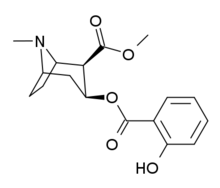 | |
| Legal status | |
|---|---|
| Legal status |
|
| Identifiers | |
| |
| CAS Number | |
| PubChem CID | |
| ChemSpider | |
| UNII | |
| Chemical and physical data | |
| Formula | C17H21NO5 |
| Molar mass | 319.357 g·mol−1 |
| 3D model (JSmol) | |
| |
| |
| (verify) | |
Salicylmethylecgonine, (2′-Hydroxycocaine) is a tropane derivative drug which is both a synthetic analogue and a possible active metabolite of cocaine.[1] Its potency in vitro is around 10x that of cocaine,[2] although it is only around three times more potent than cocaine when administered to mice (likely owing to it having a higher LogP: 2.89 than that of cocaine: 2.62)[3] Note however that the compound 2′-Acetoxycocaine would act as a prodrug to Salicylmethylecgonine in humans, and has a more efficient partition coefficient which would act as a delivery system and would circumvent this reason for a drop in potency. Salicylmethylecgonine also shows increased behavioral stimulation compared to cocaine similar to the phenyltropanes.[4] The hydroxy branch renders the molecule a QSAR of a 10-fold increase over cocaine in its binding potency for the dopamine transporter & a 52-fold enhanced affinity for the norepinephrine transporter. It also has a reduced selectivity for the serotonin transporter though only due to its greater increase at NET binding; its SERT affinity being 4-fold increased compared to cocaine.[3] However, in overall binding affinity (not uptake inhibition) it displaces ligands better across the board than cocaine in all monoamine categories.
| Compound | DAT
[3H]WIN 35428 |
5-HTT
[3H]Paroxetine |
NET
[3H]Nisoxetine |
Selectivity
5-HTT/DAT |
Selectivity
NET/DAT |
|---|---|---|---|---|---|
| Cocaine | 249 ± 37 | 615 ± 120 | 2500 ± 70 | 2.5 | 10.0 |
| 2′(ortho)-hydroxycocaine | 25 ± 4 | 143 ± 21 | 48 ± 2 | 5.7 | 1.9 |
Study of molecular modeling inferred that, in addition to intramolecular hydrogen bonding between the adjacent 3β-carbonyl and the 2′-OH ortho group of 185d (i.e. salicylmethylecgonine), that intermolecular hydrogen bonding between its hydroxy ortho substituent and the dopamine transporter was also possible; and was rationalized to be due to its nearness of where the nitrogen and oxygen atoms reside in the para-hydroxy of dopamine itself and its own intrinsic relation to DAT whereby that mutual hydroxyl functionality is mediated in both salicylmethylecgonine and dopamine in a similar manner. That is, at serine residue 359 on DAT, as the distance of the hydroxy to the bridge-nitrogen on salicylmethylecgonine is 7.96 Å (close to that of the distance between the p-OH & the NH2 atoms of dopamine, their distance apart being 7.83 Å). Which may play a role in this analogs increased behavioral stimulation over its parent compound cocaine. The meta-hydroxy group of dopamine, by contrast, has a distance of 6.38 Å from its nitrogen and is believed to engage with the 356 residue on DAT.[4]
See also
- 4′-Fluorococaine
- Benzoylecgonine
- Cocaine reverse ester
- Ecgonine
- Methylecgonine cinnamate
- Norcocaine
- RTI-160
- List of cocaine analogues
References
- ^ Singh S, Basmadjian GP, Avor K, Pouw B, Seale TW (1997). "A convenient synthesis of 2'- or 4'-hydroxycocaine". Synthetic Communications. 27 (22): 4003–4012. doi:10.1080/00397919708005923.
- ^ el-Moselhy TF, Avor KS, Basmadjian GP (September 2001). "2'-substituted analogs of cocaine: synthesis and dopamine transporter binding potencies". Archiv der Pharmazie. 334 (8–9): 275–278. doi:10.1002/1521-4184(200109)334:8/9<275::aid-ardp275>3.0.co;2-b. PMID 11688137. S2CID 41556606.
- ^ a b Seale TW, Avor K, Singh S, Hall N, Chan HM, Basmadjian GP (November 1997). "2'-Substitution of cocaine selectively enhances dopamine and norepinephrine transporter binding". NeuroReport. 8 (16): 3571–3575. doi:10.1097/00001756-199711100-00030. PMID 9427328. S2CID 24348794.
- ^ a b c Singh S (March 2000). "Chemistry, design, and structure-activity relationship of cocaine antagonists". Chemical Reviews. 100 (3): 925–1024. doi:10.1021/cr9700538. PMID 11749256.
